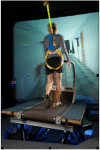Enhancing astronaut performance using sensorimotor adaptability training
- PMID: 26441561
- PMCID: PMC4584940
- DOI: 10.3389/fnsys.2015.00129
Enhancing astronaut performance using sensorimotor adaptability training
Abstract
Astronauts experience disturbances in balance and gait function when they return to Earth. The highly plastic human brain enables individuals to modify their behavior to match the prevailing environment. Subjects participating in specially designed variable sensory challenge training programs can enhance their ability to rapidly adapt to novel sensory situations. This is useful in our application because we aim to train astronauts to rapidly formulate effective strategies to cope with the balance and locomotor challenges associated with new gravitational environments-enhancing their ability to "learn to learn." We do this by coupling various combinations of sensorimotor challenges with treadmill walking. A unique training system has been developed that is comprised of a treadmill mounted on a motion base to produce movement of the support surface during walking. This system provides challenges to gait stability. Additional sensory variation and challenge are imposed with a virtual visual scene that presents subjects with various combinations of discordant visual information during treadmill walking. This experience allows them to practice resolving challenging and conflicting novel sensory information to improve their ability to adapt rapidly. Information obtained from this work will inform the design of the next generation of sensorimotor countermeasures for astronauts.
Keywords: countermeasures; motor learning; plasticity; spaceflight; training.
Figures


References
-
- Aihara T., Kitajo K., Nozaki D., Yamamoto Y. (2010). How does stochastic resonance work within the human brain?—Psychophysics of internal and external noise. Chem. Phys. 375, 616–624. 10.1016/j.chemphys.2010.04.027 - DOI
Publication types
LinkOut - more resources
Full Text Sources
Other Literature Sources

